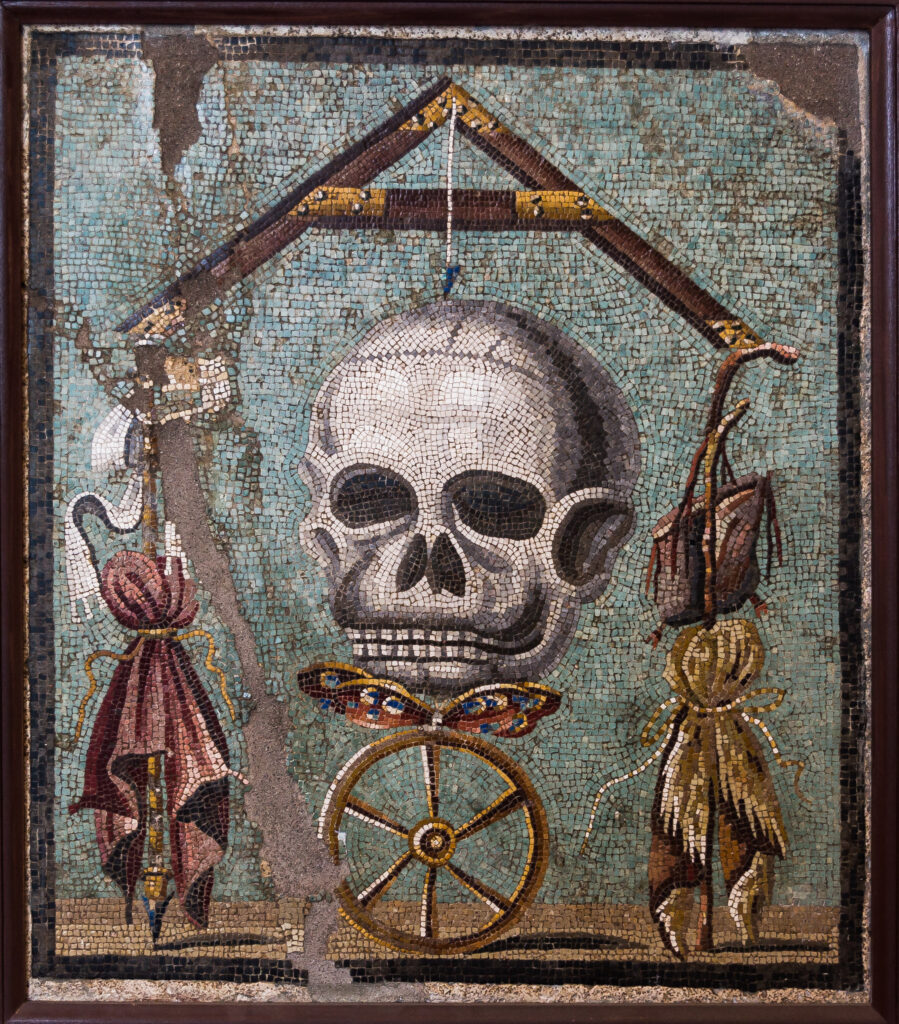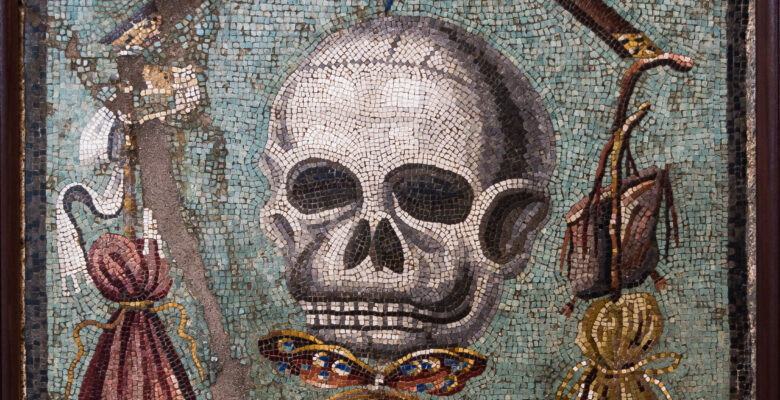Epigram of the month: Discover your inner Epicurean!
Last month we launched our new series ‘Epigram of the Month’, and we laughed with tears about an astonishing piece selected by Prof. Peter Kruschwitz. This month, Alexander Gangoly, doctoral researcher on our team, discusses a funerary inscription that emphatically shifts the focus on life itself.
In the light of current events, with a vicious virus rampaging and in the aftermath of a horrific attack on innocent people here in Vienna, to name just two of the things that are vividly on our mind, talking about death is a delicate matter.
For many epigraphists, however, death is part and parcel of their everyday business. Of course, we typically only deal with textual, not mortal, remains related to the deceased, which is very different from experiencing the deeds of the Grim Reaper first-hand. But that does not make things less delicate in present circumstances (and generally).
Every human comes into contact with death eventually: passively, at first, as a witness, and enventually, inevitably, actively also, as we all must die.
For many, death is a repulsive topic, a taboo, about which one somehow ought to remain silent.
Every society has established its own mechanisms to deal with death and the dead. These can be seen to range from ritualised offerings of food and drink to the deceased (including e. g. a shared meal among the living that were gathered at the tomb during the Roman festival of the Parentalia) to rather more horrid scenarios such as one’s leaving the body uninterred, for consumption by wild animals, especially vultures, according to Zoroastrian burial ritual, a ritual that in its substance goes back to ancient times, but has, of course, developed over time.
There are even (quite literally) dances with the dead, such as is the case at the Famadihana in Madagascar, taking the songs “Dancing Dead” and “Es lebe der Zentralfriedhof” to a whole new level.
Every person copes differently with the loss of their loved ones.
This – the astonishing range of coping mechanisms and ritualised responses – we can also encounter in ancient Roman funerary epigrams.
Sometimes, there is only weeping and moaning, followed by grieving and mourning. Sometimes the relatives seek to cheer up their lost ones, comforting them that abandoning this atrocious world was, in fact, the better option. And sometimes the deceased offer their consolation to the living.
The following inscription is a wonderful example of that latter scenario. The piece originates from an unknown locale in or around the city of Rome, and it is now preserved in the National Museum of Rome, in the Terme di Diocleziano. The inscribed limestone tablet (28 x 42 cm) can be dated to the latter half of the second or first half of the third century A. D. (IG XIV 2130 = EG 646a = IGUR III 1406 (with an image) = GVI 1367 = GG 480 = EDR 129270):
Θ(εοῖς) Κ(αταχθονίοις).
Φρόντιζ’, ἕως ζῇς, πῶς κα-
λῶς ταφήσεε, | καὶ ζῆσον ὡς
ζήσο⌜ις⌝· κάτω γὰρ οὐκ ἔχις |
οὐ πῦρ ἀνάψε, οὐδὲ διπνῆσε καλ̣ῶ̣[ς]· |
ἐγὼ λέγω σοι ταῦτα ἅπαντα πιράσα̣ς̣, |
ἐντεῦθεν οὐθὶς ἀποθανὼν ἐγίρ̣ε̣τ̣ε̣. |
To the Spirits of the Departed.
Give thought, while you live, to how
you will be buried beautifully, and live as
you want to live, because down (in the grave) you will
neither be able to light a fire nor dine well;
I tell you all these things as someone who is experienced:
no one who has died rises from the dead.
The inscription begins with a dedication to otherworldly spirits (line 1), Rome’s Di Manes, as they are called in Latin. After that, there follows a poem of six lines (lines 2–7), constisting of five iambic trimeters, wherein verse breaks and line ends do not commonly coincide.
The poem addresses its readers, but it fails to mention the name of the deceased. This is uncommon, since the purpose of a funerary inscription is, of course, the commemoration of the dead first and foremost – individuals that already after two generations would hardly be remembered by anyone without provision of personal details.
The message of the poem itself, however, firmly takes its readers to some of the most important tenets of Epicureanism.
Epicureanism goes back to Epicurus, a Greek philosopher of the third and second centuries B. C., founder of the Epicurean school – a school of philosophy that proved to be influential much beyond Epicurus’ own lifetime (incidentally, he welcomed women to the club!).
To Epicurus’ mind, everyone should aspire to lead a happy and peaceful life, free from pain and fear, free especially from any fear of death, because both body and soul were bound to die in the end (and, given that certainty, what is there to be afraid of anyway?).
This is the matter at the very heart of the thoughts that are expressed in the present epigram, and the matter that can be found in many other funerary inscriptions as well. This considered Epicurean view emphatically shifts the attention of the readers straight to the one topic that one really should focus on: life itself.
If the deceased was a devotee of Epicureanism – which seems likely, if we do not want to posit that the person who dedicated the inscription took an executive decision, or even purposefully interfered with, e. g., a dedicated Stoic’s legacy, – the epigram achieves the goal in a twofold way. First, the deceased propagates his beliefs to all those who read the inscription (and continues to do so even after closer to 1,900 years). Secondly, and, in fact, simultaneously, the readers are encouraged fear death just a little bit less: ζῆσον ὡς ζήσο⌜ις⌝, ‘live as you want to live’, line 3–4.
At this point it is important to bear in mind that, although the deceased appears to address their reader directly (ἐγὼ λέγω σοι ταῦτα ἅπαντα πιράσα̣ς̣, line 6), they did not necessarily dedicate the tablet themselves, unless we were to assume the poem had already been written and selected prior to their actual death. This in turn means that, as much as the statement may be that of a devotee, it is a comforting message directed at all those who had to cope with this loss first and foremost.

Image source: click here.
It is never easy to say goodbye to loved ones.
But as eventually we will follow them in their fate, now is the time to seize the moment, to enjoy a sunset walk, to caress your beloved pet once more, and, most importantly, to tell the people that you hold near and dear that – and how much! – you love them.
Whether you believe in an afterlife or not, it would seem certain that we all are given only one single opportunity to experience our existence on this planet, in this body, with this sensorium and conscience.
In the words of the punk rock band “Die Ärzte“:
“Wir haben nur dies eine Leben,
Wenn’s vorbei ist, ist’s vorbei.”
We have only this one life,
If it’s over, it’s over.

